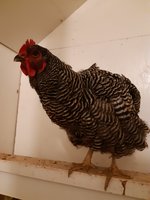- Jun 10, 2018
- 82
- 54
- 131
My almost 2yo barred rock is having a very hard moult - every day I go out it looks like the remains from a fox fight! The poor girl has multiple naked patches - neck, back, saddle, bum - and she looks like she is half the size of her previous full feathered self! All of this I am sure is quite normal, it is just shocking to see it in action for the first time. My 1yo Sussex and younger pullers obviously have not done anything like this before. My barred rock hen is a really good layer, she lays 6/7 eggs a week, and just stopped the week the moulting became extreme. I am just wondering how long I should expect her to be off from playing after such a hard moult? And would it be reasonable to think she might eventually resume her previous laying schedule, even at almost 2 years of age? I am supplementing her regular layer mash with the usual table scraps, meal worms, boiled eggs, and BOSS. They are currently not getting any free range time due to a ballsy neighborhood fox hanging around. I am just starting to leave the henhouse light on til bedtime lately to give them a bit more light.






